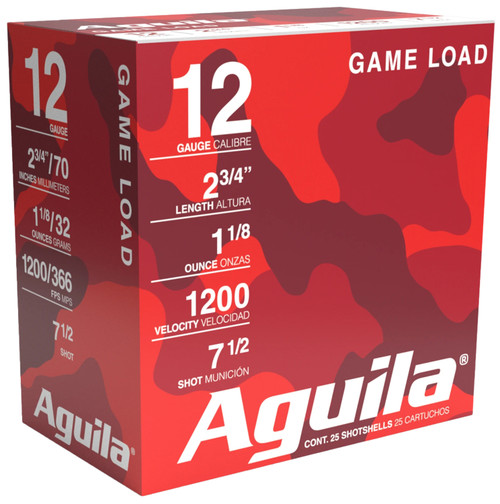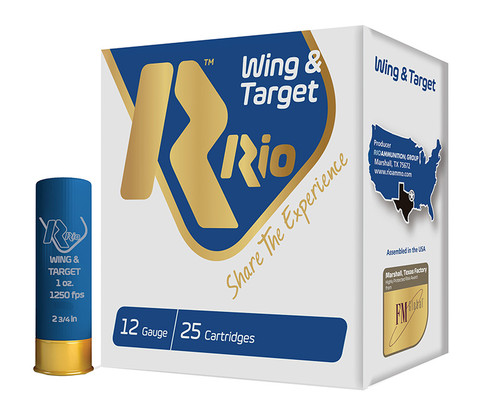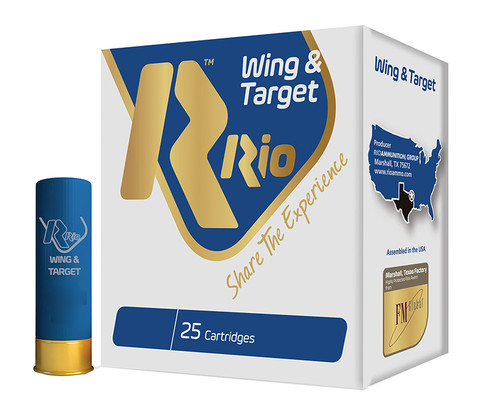12 Gauge Shells
12 Gauge Shotgun: At a Glance
| Key Characteristics | |
|---|---|
| Firearm Type | Shotgun |
| Primer Type | Shotshell |
| Used For | Hunting, Home defense, Sport shooting, Law enforcement |
| Shell Design | Rimmed, Straight-walled |
| Year Introduced | Late 19th century |
12 Gauge Shotgun: Pros and Cons
Pros
- ✔ Versatile for various shooting applications
- ✔ Wide variety of ammunition types available
- ✔ Effective for close to medium-range shooting
- ✔ Large payload capacity for increased hit probability
- ✔ Widely available and relatively affordable
Cons
- ✘ Significant recoil, especially with heavier loads
- ✘ Limited effective range compared to rifles
- ✘ Bulky ammunition with limited capacity in some designs
- ✘ Less precise than rifled firearms for long-range shooting
- ✘ Potential for overpenetration in home defense situations
12 Gauge Shotgun: In Depth
The 12 gauge shotgun is a versatile and widely used shotgun caliber that has made a significant impact in various shooting applications. Known for its power, versatility, and effectiveness at close to medium ranges, this gauge has become a favorite among hunters, sport shooters, and for home defense. The 12 gauge offers an impressive balance of payload capacity, pattern density, and manageable recoil, making it suitable for a wide range of applications from bird hunting to tactical use.
History and Development
The 12 gauge shotgun has a rich history dating back to the 19th century. The term "12 gauge" refers to the diameter of the bore, which is equal to the diameter of a sphere made from one-twelfth of a pound of lead. This standardization emerged as firearms manufacturing became more refined and consistent in the 1800s.
The development of the 12 gauge shotgun was driven by the need for a versatile firearm that could handle various types of shot and deliver effective patterns for hunting and defense. Its popularity grew rapidly due to its balance of power, range, and manageable recoil compared to larger gauges like the 10 gauge.
Manufacturers like Winchester, Remington, and Browning played significant roles in popularizing and refining 12 gauge shotguns. The introduction of smokeless powder in the late 19th century further enhanced the performance of 12 gauge shotguns, allowing for higher velocities and improved range.
Over the years, the 12 gauge has seen numerous innovations, including the development of various action types (pump-action, semi-automatic, break-action), improved choke systems for better pattern control, and a wide array of specialized ammunition types for different applications.
The 12 gauge shotgun's versatility has led to its adoption across various sectors. It has been a staple for hunters, particularly for bird hunting and medium-sized game. In sport shooting, it's widely used in disciplines like trap, skeet, and sporting clays. Law enforcement and military forces around the world have also adopted 12 gauge shotguns for close-quarters combat and specialized applications.
The popularity of the 12 gauge has resulted in an extensive range of shotgun models from numerous manufacturers, as well as a vast array of ammunition options. This includes everything from light target loads to heavy magnum hunting loads, and specialized defensive ammunition.
Key Milestones in 12 Gauge Shotgun Development:
12 Gauge Shotgun Performance
The 12 gauge shotgun offers versatile performance that has made it a favorite for various shooting applications. Here's a breakdown of its key performance characteristics:
| Characteristic | Performance |
|---|---|
| ► Velocity | 1,100-1,300 fps (birdshot) 1,200-1,600 fps (buckshot) 1,300-1,800 fps (slugs) Varies widely depending on load type and barrel length |
| → Range | Effective up to 40-50 yards (birdshot) Effective up to 50-75 yards (buckshot) Effective up to 100-150 yards (slugs) Depends on choke, load, and shooter skill |
| ⚡ Energy | 1,200-1,600 ft-lbs (at muzzle for typical buckshot load) 2,000-3,000 ft-lbs (at muzzle for typical slug load) Provides significant stopping power at close range |
| ↕ Recoil | Moderate to heavy, depending on load Can be mitigated with gas-operated actions and recoil pads |
| ⦿ Pattern Density | Highly variable based on choke and load Allows for versatility in different shooting scenarios |
12 Gauge Shotgun: Shot Size vs. Muzzle Velocity
This chart shows how shot size affects muzzle velocity for typical 12 gauge shotgun loads.
Note: Actual velocities may vary based on specific loads, barrel length, and other factors. These values are estimates for comparison purposes.
12 Gauge Shotgun: Effective Range for Different Applications
This table provides estimated effective ranges for the 12 gauge shotgun in various applications. Ranges are based on typical shot sizes and choke configurations.
| Application | Effective Range (yards) | Notes |
|---|---|---|
| Upland Bird Hunting | 20-40 | Typically uses #6 to #8 shot with improved cylinder or modified choke |
| Waterfowl Hunting | 30-50 | Often uses #2 to #4 shot with modified or full choke |
| Turkey Hunting | 40-50 | Specialized loads with #4 to #6 shot, often with extra-full choke |
| Home Defense | 0-25 | Typically uses 00 buckshot or defensive slugs |
| Slug Shooting | 0-100 | Rifled slugs in smooth bore or sabot slugs in rifled barrel |
Note: Effective ranges can vary based on factors such as choke selection, ammunition type, shooter skill, and environmental conditions. Always practice and pattern your shotgun for your specific application.
12 Gauge Shotgun: Choke Selection Guide
Choke selection affects shot pattern density and effective range. This guide helps you choose the right choke for your 12 gauge shotgun based on different applications.
| Choke Type | Constriction | Typical Use |
|---|---|---|
| Cylinder | 0.000" | Close-range hunting, home defense, slug shooting |
| Improved Cylinder | 0.010" | Upland bird hunting at close range, skeet shooting |
| Modified | 0.020" | General-purpose hunting, trap shooting |
| Full | 0.035" | Waterfowl hunting, longer-range upland hunting |
| Extra Full | 0.045" | Turkey hunting, specialized long-range applications |
Understanding Chokes
A shotgun's choke is a constriction at the muzzle end of the barrel that affects how the shot spreads after leaving the barrel.
- Tighter chokes (e.g., Full, Extra Full) constrict the shot more, resulting in denser patterns at longer ranges.
- More open chokes (e.g., Cylinder, Improved Cylinder) allow the shot to spread more quickly, ideal for close-range shooting.
- Many modern shotguns come with interchangeable choke tubes, allowing shooters to adapt to different situations.
The constriction values given are typical for 12 gauge shotguns, but may vary slightly between manufacturers.
Note: These are general guidelines. Always pattern your shotgun with different choke and ammunition combinations to determine the best setup for your specific needs.
Applications for 12 Gauge Shotgun
The 12 gauge shotgun's versatile performance profile makes it suitable for a wide range of shooting applications:
Available Firearms
The 12 gauge shotgun is available in various firearm platforms, each offering unique advantages. Here's why you might choose each platform:
Pump-Action Shotguns
Why choose: Pump-action shotguns in 12 gauge offer:
- Excellent reliability and simplicity
- Lower cost compared to semi-automatic options
- Ability to cycle a wide variety of loads
- Popular for hunting, home defense, and law enforcement
- Manual action allows for use of low-powered loads
Semi-Automatic Shotguns
Why choose: Semi-automatic shotguns in 12 gauge provide:
- Faster follow-up shots for hunting or competition
- Reduced felt recoil due to gas operation or inertia systems
- Increased capacity in some models
- Popular for waterfowl hunting and sporting clays
- Versatility for various shooting disciplines
Break-Action Shotguns
Why choose: Break-action shotguns in 12 gauge offer:
- Simplicity and reliability
- Easy to clean and maintain
- Available in single-shot, side-by-side, and over-under configurations
- Popular for upland hunting and clay target sports
- Often lighter weight than pump or semi-auto options
Tactical Shotguns
Why choose: Tactical shotguns in 12 gauge allow for:
- Enhanced ergonomics for defensive use
- Often feature shorter barrels for maneuverability
- Increased capacity with extended magazines
- Customization options for sights, lights, and accessories
- Popular for home defense and law enforcement applications
Manufacturer Options
Here are some of the manufacturers offering 12 gauge shotguns in various platforms:
- Pump-Action: Remington (870), Mossberg (500/590), Winchester (SXP)
- Semi-Automatic:Benelli, Beretta, Browning, Remington
- Break-Action: Browning, CZ-USA, Beretta, Stevens
- Tactical: Mossberg, Remington, Benelli, FN America
Available Ammunition
The 12 gauge shotgun is supported by a wide selection of factory ammunition for various applications.
| Manufacturer | Popular Loads | Application |
|---|---|---|
| Federal Premium | 3" 1 1/4 oz #2 Steel Shot | Waterfowl Hunting |
| Remington | 2 3/4" 1 oz #7.5 Shot | Target Shooting |
| Winchester | 3" 2 oz #4 Lead Shot | Turkey Hunting |
| Hornady | 2 3/4" 00 Buckshot | Home Defense |
| Fiocchi | 2 3/4" 1 oz Slug | Large Game Hunting |
Gauge Comparisons
To understand the 12 gauge shotgun's place in the shooting world, it's helpful to compare it to similar gauges. Click on each comparison to see more details:
Recoil Energy Comparison
Compare the estimated recoil energy of the 12 gauge shotgun with other popular gauges. (Based on typical loads)
Note: Recoil energy can vary based on specific loads, shotgun weight, and other factors. These values are estimates for comparison purposes.
Pattern Spread Comparison
This chart compares the pattern spread of 12 gauge shotgun loads with different choke types over distance.
Note: Pattern spreads are approximate and can vary based on specific loads, choke designs, and individual shotgun characteristics.
Energy Retention Comparison
This chart compares the energy retention of different 12 gauge shotgun loads over distance.
Note: Energy values are calculated based on typical loads for each shot type. Actual results may vary based on specific loads and environmental conditions.
Estimated Shotgun Barrel Life Expectancy
This table provides a general comparison of estimated barrel life for 12 gauge shotguns based on different usage patterns. Actual barrel life can vary significantly based on factors such as firing schedule, load types, barrel quality, and maintenance.
| Usage Type | Estimated Barrel Life (Rounds) |
|---|---|
| Casual Shooting (Low Volume) |
|
| Regular Hunting Use |
|
| Competitive Clay Shooting |
|
| Heavy Use (High Volume) |
|
| Slugs (Primary Use) |
|
Note: These are rough estimates and can vary greatly depending on usage patterns, load types, cleaning regimen, and individual barrel characteristics. Regular maintenance and proper care can significantly extend barrel life.
Shot Density Comparison
Shot density is a measure of the mass of individual pellets relative to their diameter. Higher density generally indicates better energy retention and penetration.
| Shot Type | Pellet Size | Density (g/cm³) | Relative Density |
|---|---|---|---|
| Tungsten Shot | #5 | 18.0 |
|
| Lead Shot | #7.5 | 11.34 |
|
| Hevi-Shot | #6 | 12.0 |
|
| Bismuth Shot | #5 | 9.78 |
|
| Steel Shot | #4 | 7.86 |
|
Note: Shot density affects ballistic performance, with denser materials generally offering better energy retention and penetration. However, other factors like velocity, shot size, and pattern density also play significant roles in overall performance.
Conclusion
The 12 gauge shotgun remains one of the most versatile and widely used firearms in the world. Its ability to handle a diverse range of loads makes it suitable for an extensive variety of applications, from hunting and sport shooting to home defense and law enforcement.
Hunters appreciate the 12 gauge for its effectiveness on game ranging from small upland birds to large waterfowl and even some big game when using slugs. The ability to quickly change loads allows hunters to adapt to different hunting scenarios with a single firearm.
In competitive shooting, the 12 gauge dominates disciplines like trap, skeet, and sporting clays. Its widespread use has led to a vast array of specialized ammunition and choke options, allowing shooters to fine-tune their setups for optimal performance.
For home defense and law enforcement, the 12 gauge shotgun's stopping power at close range and the option to use less-lethal ammunition make it a valuable tool. The psychological deterrent of a shotgun's distinctive sound when chambering a round is often noted as an additional benefit in defensive situations.
The popularity of the 12 gauge has ensured a constant stream of innovations in shotgun and ammunition design. From advanced materials in shot pellets to improvements in shotgun actions and recoil reduction systems, manufacturers continue to enhance the performance and user experience of 12 gauge shotguns.
While other gauges have their niches, the 12 gauge's balance of power, versatility, and widespread availability ensures its position as the standard shotgun gauge for a diverse range of shooters. As technology advances, the 12 gauge shotgun is likely to remain at the forefront of shotgun applications, continuing its legacy as one of the most adaptable firearms available.
12-Gauge Shotgun: FAQ:
These terms refer to different types of shotgun loads. Birdshot consists of small pellets (typically numbered from 9 to 1) used for hunting birds and small game, or for clay target shooting. Buckshot uses larger pellets (typically numbered from 4 to 000) for hunting medium to large game and for self-defense. Slugs are single, large projectiles used for hunting big game at longer ranges or for law enforcement/military applications.
No, you should not use 3-inch shells in a shotgun chambered for 2 3/4-inch shells. Always use shells that match your shotgun's chamber length or shorter. Using longer shells can cause dangerous pressure buildup and potential damage to your firearm. However, you can typically use 2 3/4-inch shells in a 3-inch chamber safely.
Dram equivalent is an outdated measure of powder charge that relates to the days of black powder. Today, it's used to give a general idea of the shell's power or velocity. Higher dram equivalents generally indicate higher velocities. However, it's more accurate to look at the actual velocity rating (usually given in feet per second) for modern shells.
Choke selection depends on your shooting application. Cylinder or Improved Cylinder chokes are best for close-range shooting, home defense, or shooting slugs. Modified chokes are good all-purpose options for medium-range shooting and hunting. Full chokes are ideal for longer-range shooting, such as waterfowl hunting or turkey hunting. Always pattern your shotgun with different chokes and loads to find the best combination for your specific needs.
Steel shots are less dense than lead, which means they lose energy faster and have a shorter effective range. However, they are required in many areas for waterfowl hunting due to environmental regulations. Steel shots can be effective when used properly: use larger shot sizes compared to lead (e.g., #2 or #1 steel instead of #4 lead), expect shorter effective ranges, and consider using tighter chokes to compensate for the less dense pattern. For upland hunting or target shooting where lead is allowed, many shooters still prefer lead for its superior ballistic properties.











